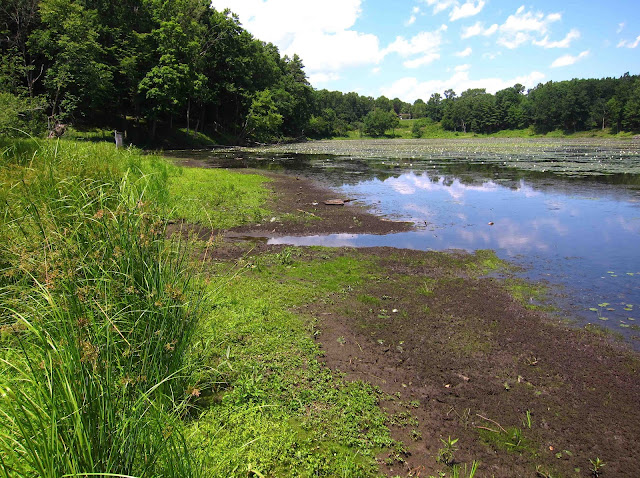Oof! That heat outside sure was stifling today. But lucky for me, I had chores to do inside my cool house, and I was happy for once to resist the call of the great outdoors. Besides, I got my nature fix going over more of yesterday's photos, taken after I left the river and stopped off at Moreau Lake State Park to circle Mud Pond on the trail that runs through the woods.
My friend Sue had found a large patch of Checkered Rattlesnake Plantain (Goodyera tesselata) along the east side of the pond, and I was eager to check on the state of their buds. A fellow nature enthusiast is coming all the way from Ohio the second week of July specifically to see some of New York's native orchids, so I'm hoping these tight green buds will be ready by then to show him their little white flowers. This is not one of our showiest orchids, but hey, it's still an orchid!
Yes, I think that at least a few will be open ten days from now.
For quite a while now, there haven't been many flowers blooming in the deep shade of the woods, but yesterday I saw the first pretty pink blooms of Pointed-leaf Tick Trefoil.
When the trail reached the western side of the pond, I followed a stream bed out to the shore, where a muddy flat lay baking under the sun.
This flat was covered with many different kinds of plants well-suited to this habitat. The tiny white flowers here are Clammy Hedge-hyssop and the little blue ones are False Pimpernel, both poking up from a solid groundcover of Water Purslane.
Here's a little clearer shot of that Clammy Hedge-hyssop, and it also shows the reddish sprawling stems of the Water Purslane, which will have flowers later on in the season, but such tiny ones you can barely see them.
Poking up from the almost uniform green of the mudflat plant carpet were these silvery tufts of Low Cudweed, a mud-loving relative of Pearly Everlasting that never grows any bigger than this little clump.
Back further from the shore, amid the tall growth of sedges and rushes, I found a patch of Bur Reeds, with fluffy white staminate flower heads riding higher on the crooked stalk than the lower-growing pistillate heads that look like spiky burs. It will be easier to tell what species of Bur Reed this is, after the pistillate heads develop into clusters of nutlets whose shape is distinctive for each species. This might be Lesser Bur Reed (Sparganium americanum), since the whole plant was only about 18 inches high.
The place was a-whirr with the constant zipping-about of dragonflies, and I noticed one Twelve-spotted Skimmer always returned to this perch each time it flew off. Let me see if I can sneak up on it.
Success! After at least a dozen tries, I finally inched close enough to get a clear shot the next time the dragonfly landed. I guess when they named this dragonfly, they only counted black spots.
Here was another dragonfly with a chalky-white tail, this one called, aptly enough, the Common Whitetail. Note the distinctive dark-brown patterns on the wings. Those shapes remind me of skates' egg cases (Mermaids' Purses).
A third dragonfly with chalky-white markings was kind enough to sit for a photo. This one is called Chalk-fronted Corporal, for the markings on its thorax that look like an army corporal's stripes.
One more bug, a big green grasshopper, species unknown. It kept trying to hide on the underside of this leaf, but always kept at least one brown eye peering out at me.














3 comments:
I think they'll be just fine :) Can't wait!
You are becoming quite the dragonfly photographer! Lucky you :)
I think dragonflies might be fairies in disguise . . . their wings look so magical.
The Bur Reed looks like fireworks!
Post a Comment